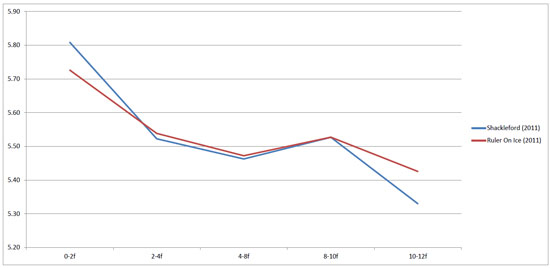Belmont: It's More About Pace Than Distance
Written by Ian Tapp | Jun 08, 2012 |
Comments
Approaching the Belmont Stakes (gr. I)—the longest leg of the Triple Crown—why does it seem that those day-and-night distance questions we asked for every starter going into the Kentucky Derby (gr. I) are now pushed to the back burner? Now we focus more on the riders, and who has the experience to ride effectively in what is a most unusual race.
With its 20-horse fields and typically absurdly fast pace, the 10-furlong Derby is often a truer "stamina" test than the 12-furlong Belmont, which is by contrast a game of pace and tactics. To illustrate, see the chart below of the last 20 Belmont winners with their pace (lengths per second) at each point of call.
Generally, this race is won with controlled deceleration. Only five winners in the last 20 years (A.P. Indy, Touch Gold (TrueNicks,SRO), Victory Gallop (TrueNicks), Afleet Alex (TrueNicks,SRO), and Rags to Riches) increased their average speed in the final quarter-mile, and just two winners (Afleet Alex and Rags to Riches) made their final quarter their fastest overall quarter.
Increasing speed throughout the Belmont is atypical, but it happened in 2007. The early pace was soft, and in a shorter field all riders were happy with their positions, meaning there was no customary "attack" on the backstretch. Instead, the field steadily increased the pace. This ended up favoring John Velazquez and Rags to Riches, who sat in an advantageous position just off of Curlin (TrueNicks,SRO) and kept the flatter line of pace.
 Rags to Riches vs. Curlin, 2007 Belmont, lengths per second at each call (click to enlarge) Rags to Riches vs. Curlin, 2007 Belmont, lengths per second at each call (click to enlarge) |
Keeping a steady, flat line of pace is the most productive tactic. Historically, the easiest way to lose the Belmont is to run too strong of a half-mile down the backstretch, but resisting this move must be counter-intuitive for jockeys, since this is the point where most (shorter) races are won. Premature moves were the undoing of recent near Triple Crown winners Silver Charm, Real Quiet, Charismatic, and Smarty Jones (TrueNicks,SRO). Each of these responded to challenges that forced their hand too soon and left them vulnerable in the final quarter-mile.
The 1997 Belmont was one of the most tactical races, well, ever. Chris McCarron, on Touch Gold, set a rapid opening quarter (:23 3/5) but then cleverly eased back off the pace down the backstretch. Meanwhile, Silver Charm was kept closer and pressed new leader Wild Rush, while Touch Gold sat in reserve and held a flatter line of pace from the backstretch onward.
 Touch Gold vs. Silver Charm, 1997 Belmont, lengths per second at each call (click to enlarge) Touch Gold vs. Silver Charm, 1997 Belmont, lengths per second at each call (click to enlarge) |
I asked Alan Porter (of Pedigree Consultants and developer of TrueNicks) for his thoughts on pace scenarios in the Belmont vs. the Kentucky Derby:
"In the Derby, I think it takes running at a pace that places a higher demand on cruising speed to stay in a striking position. You either have to be able cruise relatively fast without creating lactate build up or you have to be able to tolerate significant amounts of lactate," Alan said.
"The demands on the systems are a bit different in the Belmont. It's actually interesting looking last year at Shackleford, who is a horse that can tolerate a fast early pace (better than most) and who was on the lead in the Kentucky Derby and stayed on fairly well; battled through fast fractions in the Preakness and won it; got away with much slower in the Belmont and folded up at the top of the stretch. He's probably a horse whose key attribute is very good lactate tolerance, but who must be very much a fast-twitch horse."
In other words, speed must be more carefully rationed out in the Belmont. Even though Shackleford's fractions were slower compared to his Preakness and Derby, his opening Belmont quarter was still too fast for the race. Note the flatter pace line of winner Ruler On Ice.
 Ruler On Ice vs. Shackleford, 2011 Belmont, lengths per second at each call (click to enlarge) Ruler On Ice vs. Shackleford, 2011 Belmont, lengths per second at each call (click to enlarge) |
TrueNicks Enhanced Reports for the Belmont Stakes Field
UPDATE: See Union Rags vs. Paynter Pace Graph
comments powered by